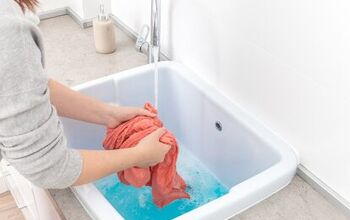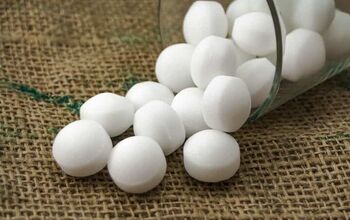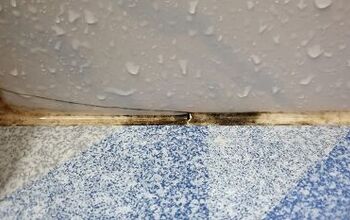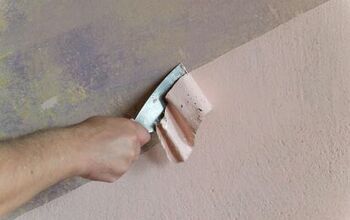How To Get Rid Of Paint Smell (11 Ways To Do It!)

Revitalizing your home with a fresh coat of paint is a great way to bring new life to your living spaces. Unfortunately, with this great look often comes lingering undesirable paint fumes. In fact, the fumes from the paint can persist in the space even long after the last coat has finished curing. The smell of paint can be especially difficult for those who are sensitive to chemicals or heavy scents.
These unpleasant odors are all thanks to VOCs, or volatile organic compounds, that come from the materials that are used in the construction of paint. The VOCs in the paint are what emit that infamous freshly painted odor. Although you can reduce the impact of these smells on your home by selecting a paint formula that contains a low number of VOCs, the fumes will often still be noticeable.
Do You Need Painting or Staining Services?
Get free, zero-commitment quotes from pro contractors near you.

11 Ways to Get Rid of the Smell of Paint
Regardless, if you’ve just finished painting, there are some things you can do to help get rid of that unwanted paint smell in your home. The following are some ways to eliminate paint fumes using common household products.
Method 1: Increasing Ventilation
Proper ventilation is a must for any paint job. This includes opening windows, doors, and potentially bringing in fans to improve air circulation to the space. In fact, fans can also help to remove paint fumes quicker. Position box fans in the center of the room you are painting and angle them towards windows and doorways.
However, keep in mind that implementing fans will speed up the drying process so may want to make sure that you complete your work before you bring them in. You’ll also want to prevent the fumes from infiltrating into other areas of your home by closing air vents in the room and turning off heat or air-conditioning.
Method 2: Buckets of Water
In some cases, the simplest of solutions can be the most effective. Ordinary buckets filled with water can absorb the odor that lingers from fresh paint. Place several buckets filled with water throughout the painted room and allow them to sit overnight. Amazingly, this trick can be tracked all the way back to 1899 with a book called “The Expert Cleaner.”
For an even more effective solution to lingering paint fumes, you can combine the water with other odor-absorbing liquids.
Method 3: Vinegar and Water
Although water can absorb VOCs on its own, you can add apple cider or distilled white vinegar to the water for better results. Mix equal parts vinegar and water in small bowls and place them in every corner of the room.
You can also use white or apple cider vinegar on its own (about one cup’s worth), and this will also be effective at removing paint fumes without adding any additional toxicity to the air. Vinegar contains acetic acid that works at neutralizing the molecules that cause odors.
For faster results, opt for household white vinegar that contains 10% acetic acid instead of culinary white vinegar. Culinary white vinegar contains a smaller percentage of acetic acid, about 5%.
Method 4: Lemon Water
In addition to vinegar, you can add lemon to the water for an effective solution for removing paint odors. The lemon will add a clean citrus scent that is more pleasing and refreshing than household vinegar. Add several slices of lemon to the water or squeeze a few lemons and mix the juice with the water. Sprinkle some salt into the lemon water to further enhance your results.
Since it takes much longer for water to absorb paint VOCs than other methods, plan to leave the containers of lemon water in the room for several hours or overnight.
Method 5: Onions
Believe it or not, onions can also absorb the VOCs produced from a fresh coat of paint. This trick takes advantage of the ordinary odor-absorbing abilities of onions. Although it may be a toss-up as to which odor is worse (fresh-cut onions or paint fumes), onions will not cause toxic harm to your health.
Syn-propanethial-S-oxide is the chemical that produces that distinctive onion smell. This compound helps to neutralize the chemical that generates paint smells, or aldehydes. Follow these steps to use onions for getting rid of paint odors:
- Peel two medium-sized onions and slice them in half across the rings. Cut them as you would if you were adding large slices to a burger.
- Put each onion half in a small bowl with the cut end facing up.
- Position these bowls in each of the corners of the painted room.
- Allow the onions to sit for several hours so they can absorb the paint odors.
- After the appropriate amount of time, remove the onions and dispose of them in the trash. The onions will have absorbed toxic VOCs and should not be used for cooking.
Method 6: Activated Charcoal
Another eco-friendly option for eliminating the odor produced by paint is charcoal. While briquettes that are intended for use on the grill will suffice in a pinch, you’ll have quicker results with activated charcoal. You can purchase activated charcoal in a crushed formula or small pouches from your local hardware store.
Activated charcoal is made porous by treating it with high-heat, creating more areas for odor-causing molecules to escape to. Its porous nature allows for activated charcoal to be one of the most-effective odor absorbers out there. To use, place the charcoal into tins or aluminum baking pans around the room and leave them to sit overnight.
Method 7: Baking Soda
You’re probably already aware of baking soda’s ability to absorb odors in your refrigerator or laundry. It can also be used to capture undesirable paint fumes. You have a couple of options for using baking soda to fight paint smells:
- Fill up several small bowls with baking soda and place them all around the room. Let the powder sit in the room overnight and then discard it in the morning.
- Although baking soda is effective no matter the room, those with soft surfaces that are prone to hanging onto odors (carpeting) will especially benefit from it. Sprinkle the powder all over your carpeting and on any upholstered furniture after painting. Let it sit overnight and vacuum it up in the morning.
- Fill small bowls with a couple inches of water and mix in ½ cup of baking soda. Stir thoroughly to dissolve the powder and position the bowls around the painted room. All at least 24 hours for the baking soda to fully absorb the odors and then discard.
Instead of throwing the baking soda in the trash, you can do double-duty by dumping it down your garbage disposal. This will help you get the most out of your baking soda and perform a quick little refresh at your disposal.
Method 8: Coffee Grounds
Using coffee grounds is another great way to absorb paint fumes while painting. This option is especially desirable for coffee lovers who want their home to be deodorized and smell like a coffee shop while they work. It may even help keep you energized and feel more alert until the paint job is complete. Simply place several bowls of coffee grounds around the room to effectively eliminate any paint smells.
Once you’re done using the coffee grounds, they should be disposed of in the trash. Although coffee grounds can be composted, these will now contain harmful VOCs and should not be added to your compost pile.
Method 9: Candles
Simply burning candles can help to absorb odors, but you should pay special attention to the candle that you select for the job. It can be difficult to know what ordinary candles found around the home are comprised of. Paraffin-based candles can actually introduce more toxins into the air. Instead, opt for a natural beeswax or soy-based candle to have air that is the safest to breathe.
- Position one or two candles in fire-safe holders on opposite sides of the painted room. You can purchase candles that are specially designed for eliminating odors. These can often be found at smoke shops or in the household aisle of most convenience stores.
- Light the candles and let them burn for several hours. As they burn, the candles will absorb paint smells while also leaving your room smelling fresh and clean.
You also may want to block off access to the room for children and pets while the candles are lit.
Method 10: Natural Extracts
Another way to successfully deodorize a room that is plagued by unpleasant paint odors is to introduce natural extracts. Vanilla and peppermint are two excellent essential oils that will eliminate paint smells and refresh the air in your painted rooms.
Simply put a few droplets of the oils onto cotton balls and place them in saucers or bowls. Scatter the bowls with the extract around the room. Additionally, some expert painters assert that adding a drop or two of the essential oils directly to paint cans before you even begin the work can effectively reduce paint odors.
Method 11: Diatomaceous Earth
Diatomaceous earth, kieselgur, or diatomite, is a naturally occurring siliceous sedimentary rock that is found in a soft, crumbled white powder. It is essentially a large silica packet for an entire room. In fact, this chalky powder’s odor and moisture absorbing qualities come from its inherently high silica content.
Choose a food-grade diatomaceous earth that can be often be found at hardware stores or purchased online. Conventional diatomaceous earth may irritate your lungs and can be harmful to pets and children. Pour the food-grade diatomaceous earth into disposable aluminum tins or empty coffee cans and position them around the painted room.
Do You Need Painting or Staining Services?
Get free, zero-commitment quotes from pro contractors near you.

How to Avoid Heavy Paint Fumes From the Beginning
Addressing paint smells before you even begin painting can help simplify the process and reduce fumes from the very start. Here are some things that you can do to help avoid producing heavy paint fumes:
- Check the weather forecast in your area. Paint on a day that has conditions of low humidity and avoid days where the humidity is high. When the air contains high humidity, paint dries much slower and produces the strongest odors both when it is being applied and as it is drying. In fact, the longer the drying process, the more probability that soft materials (drapes, upholstery, carpet) have to absorb the paint odors.
- Select a paint formula with low or zero VOCs (volatile organic compounds). While it isn’t always possible, this is the best way to avoid such intense paint smells. If you have to use an oil-based paint or primer, opt for one that claims to be “low-odor.” These types of paints are generally less toxic to the environment, as they are made from clay, minerals, milk, or plants.
- Allow ample time for drying between coats. Walls that are damp will trap fumes and slowly produce toxic gases over a longer period of time. Also, make sure to keep lids closed on paint cans and cover-up trays and brushes when not in use.
As previously mentioned, with any paint project it is essential that you have proper ventilation. Open windows and doors to allow the paint fumes to escape and dissipate into the air. This is possibly the best thing you could due to reducing paint smells in your home.

Jessica considers herself a home improvement and design enthusiast. She grew up surrounded by constant home improvement projects and owes most of what she knows to helping her dad renovate her childhood home. Being a Los Angeles resident, Jessica spends a lot of her time looking for her next DIY project and sharing her love for home design.
More by Jessica Stone



























